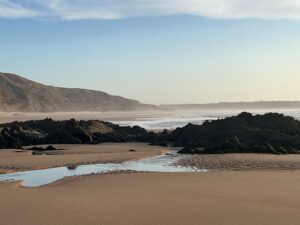The Fisherman’s Trail is considered one of the most beautiful trails in the world. Isn’t that a statement? Well, you’re truly in for a treat! A transformative journey through some of Portugal’s most captivating landscapes along the breathtaking Southwest Alentejo and Algarve coastlines.
Picture this: you stand atop a rugged cliff, the salty breeze on your skin, as the pristine waters of the Atlantic stretch endlessly before you. This is the allure of the Fisherman’s Trail, a 220-kilometer path through some of the most stunning coastal scenery you’ll ever lay eyes on. You’ll encounter a tapestry of landscapes, from windswept dunes to lush pine forests. Keep your eyes peeled for glimpses of elusive wildlife, from majestic birds of prey to playful dolphins.
But it’s not just about the views. Along the way, you’ll explore quaint fishing villages where time seems to stand still, and ancient ruins that tell tales of civilizations long past.
The 13 Stages of the Fisherman’s Trail
This is a plan for you, whether you’re an avid hiker seeking a challenge or a casual explorer in search of tranquility. With its well-marked paths and diverse terrain, you can tailor your adventure to suit your preferences. You can embark on a multi-day trek or simply take a leisurely stroll.
Each stage of the Fisherman’s trail offers a unique blend of scenery, challenges and attractions:
- S. Torpes to Porto Covo (10.2 kms): This is actually a recently added section to the path. It’s one of the shortest and easiest stages of the trail. Most of the route is on the actual road, which fortunately isn’t too busy. And this is one of the reasons most hikers still prefer the originally starting point.
- Porto Covo to Vila Nova de Milfontes (19.7 kms): This was the original start of the Fisherman’s trail. The route may sometimes take you away from the sea, but it’s possible to walk along the coast for this whole section. The biggest challenge on this one is walking on the sand dunes.
- Vila Nova de Milfontes to Almograve (14.7 kms): Vila Nova the Milfontes is a picturesque village and a lovely choice to stay overnight. We have a tip for you: you can skip around 4kms of the path if you take the boat from the fort to the beach Praia das Furnas. Some hikers do this, as the initial bit of the path is crossing the village and along the road until you cross the bridge to Praia das Furnas, which is not as scenery.
- Almograve to Zambujeira do Mar (21.5 kms): Although this bit of the route takes you more inland, you’ll still have beautiful sights of the sea and lovely small beaches along the way. One of the highlights of this section is Cabo Sardão and it’s lightouse.
- Zambujeira do Mar to Odeceixe: (18.9 kms): This is where Alentejo and Algarve meet! Most of the route takes you along the coast, next to the ocean. The last 4kms are on the road to Odeceixe, so not as scenic but still beautiful.
- Odeceixe to Aljezur (22.6 kms): There are two possible routes from Odeceixe to Aljezur. If you take the inland option, you’ll save yourself around 5kms. The longer path takes you through the Odeceixe beach, so choose this option if you’re up for yet another beautiful sight of the beach.
- Aljezur to Arrifana (17.1 kms): As the previous stage of the trail, this one also offers two alternatives, inland and along the coast. And, to no surprise, the shorter route is the inland one, and saves you around 5 kms. Some more adventurous and challenge-driven hikers chose to skip Arrifana all together and walk 31kms to Carrapateira.
- Arrifana to Carapateira (19.5 kms): If you don’t skip this stage, you’ll be walking inland most of the path. It does get close to the sea on a couple of occasions and when arriving to Carrapateira you can definitely take a detour to Praia da Bordeira, before making your way to the old town.
- Carrapateira to Vila do Bispo (15.3 kms): If you’re a beach lover, take the opportunity to have a break and enjoy it in the morning. The path on this stage is fully away from the sea, unless you detour through Pontal da Carrapateira circuit, with beautiful views over the rugged cliffs.
- Vila do Bispo to Sagres (20.2 kms): On this stage you’re making your way to Portugal’s southwesternmost point at Cabo de São Vicente. The site is
- Sagres to Salema (19.5 kms): Sagres used to be the finish line for the Fisherman’s Trail. The route has since been extended and continues until Lagos. This is one of the toughest stretches of the trail, with steep ascents and descents with loose rocks. Be prepared for this one and plan your stops, water and snacks. The views will make it all worth it!
- Salema to Luz (11.5 kms): This section of the path takes you along the coast with yet another set of beautiful views. If you were hoping for warmer water, you might very well find it. So take the opportunity to jump in the sea and get some rest before hitting the last stage of the trail.
- Luz to Lagos (10.9 kms): If you’ve hiked the whole trail, you’re in for a treat. This is one of the easiest stages, making it a delicious ending to a beautiful journey. This path offers breathtaking views over the beaches giving you a taste of the south coast of the Algarve. One of the highlights is Praia do Camilo, which is not so busy before the peak season – you should try it!
Getting There and Getting Ready

Before embarking on your adventure along the Fisherman’s Trail, it’s essential to plan and prepare accordingly. If you’re starting from the northern end of the trail, Porto Covo serves as an excellent starting point. Located approximately 170 kilometers south of Lisbon, Porto Covo can be reached by car or bus in about two hours. Alternatively, you can begin your journey from the southern end of the trail, Lagos. Lagos is easily accessible by car or public transportation, with regular train and bus services connecting it to major cities like Porto, Lisbon or Faro.
As you prepare for your hike, there are several essential pieces of advice to keep in mind. Ensure you have the proper hiking gear, including sturdy footwear, breathable clothing, and a lightweight backpack. An adventure like this can be demanding on the body, especially if you’re planning to do the full trail. With proper preparation and a sense of adventure, you’ll be ready for an unforgettable journey.
10 Quick Tips for Hiking the Fisherman’s Trail
- Best time to hike the Fisherman’s trail is between September and June. Or better yet – between September and November (fall) or between March and early June). You’ll avoid the rainy and windy season as well as the hottest months of the year;
- You don’t have to walk the whole route. You can walk specific sections and on both directions;
- Get a guidebook or a map of the trail;
- This is a given, but… bring enough water and some snacks to keep you energized;
- Some sections don’t have restaurants or cafes available for long stretches of the path. Don’t leave this detail out of your planning;
- Book accommodation ahead. If you’re hiking various stages of the trail, you might benefit from booking your stay ahead and get the best rates;
- Be careful! While the views are beautiful, don’t risk going too close to the edge. There are bits of the trail where the path can be a bit more challenging;
- Consider organizing luggage transportation and delivery so you don’t carry all that weight throughout the trail;
- Portugal is well known for its climate, and you’ll most likely catch some sun, even during the winter. Make sure you don’t forget your sunscreen, hat and sunglasses;
- Be respectful of the nature and your surroundings. You’ll be crossing protected areas, with lots of wildlife and vegetation. – “Take nothing but pictures, leave nothing but footprints”
So, what are you waiting for? Lace up your hiking boots, pack your sense of adventure, and set off on a journey of discovery. Let the rugged beauty of the Alentejo and Algarve coastlines captivate your soul and leave you with memories to last a lifetime. Ready to start planning your adventure?





